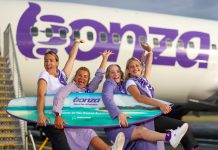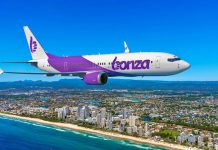“Soggy, small, cold, fatty and tasteless”. These are the words we hear all too often when people describe their in-flight meal. Personally, the fact that someone serves me a meal that I don’t have to cook is enough to satisfy me, but in a world where passengers continue to demand cheaper airfares, the quality of meals is being compromised and meals on low cost carriers are without a doubt some of the worst.
Alpha Flight Catering (AFC) have ten kitchens across Australia at nine of the major airports. In 2006 the company served just 6 airline customers, it now serves 30. The company produces 15 million airline meals a year and employs 140 chefs. I spoke with Peter Round, Unit Manager at Alpha Catering Perth to sort the fact from fiction when it comes to in-flight meals.
The first misconception he states is that “The travelling public believes all airplane meals are frozen but this is caterer specific and at Alpha they work on a fresh not frozen model meaning all food served to their customers is exactly that, fresh”. He continued, “Across Australia all the ingredients are sourced from the same supplier and taste testings happen three times per week so no matter what port you leave from in Australia your meal should look and taste identical to that on an equivalent flight”. However, he adds, they can only do so much on the ground.
Meals are heated in ovens on board with the instructions varying with the type of ovens on board. For example; In the Dry heat mode ovens, 15 minutes at medium heat (apx 150°C) and in the Steam heat mode ovens: 20 minutes under the medium heat / 130°C. Does this always happen? No, and for the most part this is why a meal will be substandard when served to you especially in economy class when some 300 meals are being served at the same time. Another misconception is that just because the meals come from the same supplier it means they will all be the same quality for every airline.
Peter shared that different airlines have different recipes for similar meals – some will call for different brands of base ingredients at differing cost and quality , while others dictate the use of the more traditionally cheaper cuts of meat for use in stews, curries and the such. At the end of the day, the catering company will cook to the recipe and costs stipulated by the airline and cost will come before taste most of the time.
The reason economy class has all plastic? It’s not to do with security any more – it’s to do with weight. The more weight, the more fuel burn, and in isolation it’s nothing but over a year the savings in weight and therefore fuel are significant and matter. Wonder where the toothpick on your tray has gone? Even they collectively add up to a significant amount of fuel burn and cost.
Malaysia Airlines is amongst the world’s most generous when it comes to in-flight catering giving passengers more grams of protein per meal than most airlines. Despite this, they too have been hammered with bad press about some of their meals (namely the sausage roll out of the eastern states which has now been scrapped). The airline has a culinary team here in Australia that works with the caterer. Included in this team are chefs from Malaysia to guarantee the authenticity that the airline are well known for.
Getting a meal to the “tray table” requires close collaboration by the airline (who ultimately sets the standards), the chefs who play with the flavours and recipes to ensure it tastes good in the air and then there is the caterer that has to produce it all and get it to the aircraft.
Malaysia Airlines and AFC invited me to sample 36 of their new meals across economy and business class to get a better understanding of the process from catering centre to passenger and to show why the relationship between the caterer and the airline is crucial.
Quality across the cabin
For Malaysia Airlines’ passengers, both economy (EY) and business class (BC) receive the same bread and croissants in terms of recipe, it’s just the portion size that varies.

Breakfast: The most important meal of the day

Malaysia’s current breakfast menu for economy passengers consists of a western and asian dish. With the western dish being more popular, the airline chooses to load each aircraft with 30 per cent of the asian and 70 per cent of the western meal. Business class also features a western and asian dish as well as a third option, in today’s case it was pancakes and waffles. I was astonished to realise that the Nasi Lemak is virtually the same meal in both the business and economy class meals, the only difference is again, the portion size and the amount and type of prawns. Which raises another very important point. Given the option of both meals the one presented on china with a garnish i.e. the business class meal will taste better every time not because the food is different but because it is presented differently and heated in a lot more space with more care and attention. The eggs and sauce in both the economy and business dishes were perfection but cramming it into an economy tray gives it a somewhat ‘uninviting” look so before the mouth has even tasted the food, the brain has decided “it’s not going to taste good”.

In another rarity, Malysia Airlines is amongst only a few that still serve seafood on a regular basis to economy passengers. Peter reports that every airline around the world will offer a chicken dish for every hot lunch or dinner service as every one that eats meat “eats chicken”. On today’s lunch menu was “the chicken or the fish”.

I can’t lie, the difference in taste between the business and economy meals was noticable. The business class meals were quite simply, perfect, with a magnificent balance of flavour and texture. Never have I had a lamb shank that melts in the mouth quite like this. Economy however didn’t disappoint with rich flavours, beautiful fish, smooth potato and fluffy rice. Dessert was also a highlight as was the fruit.

The highlight of the day though was the “chef on call” special, grilled lamb cutlet with sage sauce and puree peas. Business class passengers on Malaysia can go online 24 hours before their flight and choose from an extensive online menu rather than decide on board from the menu options available. 
From catering centre to aircraft
In business class the salads come pre-plated as the crew simply don’t have the time nor are they trained on how to assemble the perfect salad. Airlines have manuals that both the catering companies and crew use to ensure that what you are presented with matches the expectation.
The main meals however, are loaded on to the aircraft in aluminium trays and then assesmbled on board. Sauces and garnishings are applied to the meal seperately. Aluminum trays are light weight and also assist in heat transfer.
The make shift galley at the catering centre. Menu design is more then just following the recipe. The recipe is the final product after many hours in test kitchens with an aircraft galley type of set up inclusive of aircraft ovens.
A lot of effort goes in to making fresh food for an aircraft full of people and there are of course challenges such as reheating, keeping the food warm in the carts and of course the changes to taste buds that occur at 36,000 feet. Although we love to gripe about it, the quality of the food served on a premium airline is excellent value particularly considering the lower than ever fares we are paying. We the economy passengers however just need to look past the plastic.
Suggested read: See inside the Malaysia Airlines catering centre in Kuala Lumpur























